2000 年全国硕士研究生入学统一考试英语试题
Section II
Cloze Test
If a farmer wishes to succeed, he must try to keep a wide gap between his consumption and
his production. He must store a large quantity of grain 大 41 家 consuming all his grain
immediately. He can continue to support himself and his family 大 42 家 he produces a surplus.
He must use this surplus in three ways: as seed for sowing, as an insurance 大 43 家 the
unpredictable effects of bad weather and as a commodity which he must sell in order to 大 44 家
old agricultural implements and obtain chemical fertilizers to 大 45 家 the soil. He may also
need money to construct irrigation 大 46 家 and improve his farm in other ways. If no surplus
is available, a farmer cannot be 大 47 家 . He must either sell some of his property or 大 48 家
extra funds in the form of loans. Naturally he will try to borrow money at a low 大 49 家 of
interest, but loans of this kind are not 大 50 家 obtainable.
41.
42.
43.
44.
45.
46.
47.
48.
49.
50.
[B] as well as [C] instead of
[D] more than
[B] much as [C] long before [D] ever since
[A] other than
[A] only if
[A] for [B] against [C] of [D] towards
[A] replace [B] purchase [C] supplement [D] dispose
[A] enhance [B] mix [C] feed [D] raise
[A] vessels [B] routes [C] paths [D] channels
[A] self-confident [B] self-sufficient [C] self-satisfied [D] self-restrained
[A] search [B] save [C] offer [D] seek
[A] proportion [B] percentage [C] rate [D] ratio
[A] genuinely [B] obviously [C] presumably [D] frequently
Section III
Reading Comprehension
Text 1
A history of long and effortless success can be a dreadful handicap, but, if properly handled,
it may become a driving force. When the United States entered just such a glowing period after
the end of the Second World War, it had a market eight times larger than any competitor, giving
its industries unparalleled economies of scale. Its scientists were the world’s best, its workers
the most skilled. America and Americans were prosperous beyond the dreams of the Europeans and
Asians whose economies the war had destroyed.
It was inevitable that this primacy should have narrowed as other countries grew richer. Just
as inevitably, the retreat from predominance proved painful. By the mid-1980s Americans had found
themselves at a loss over their fading industrial competitiveness. Some huge American industries,
such as consumer electronics, had shrunk or vanished in the face of foreign competition. By 1987
there was only one American television maker left, Zenith. (Now there is none: Zenith was bought
by South Korea’s LG Electronics in July.) Foreign-made cars and textiles were sweeping into the
domestic market. America’s machine-tool industry was on the ropes. For a while it looked as though
the making of semiconductors, which America had invented and which sat at the heart of the new
computer age, was going to be the next casualty.
All of this caused a crisis of confidence. Americans stopped taking prosperity for granted.
They began to believe that their way of doing business was failing, and that their incomes would
therefore shortly begin to fall as well. The mid-1980s brought one inquiry after another into
the causes of America’s industrial decline. Their sometimes sensational findings were filled
with warnings about the growing competition from overseas.
1
�
How things have changed! In 1995 the United States can look back on five years of solid growth
while Japan has been struggling. Few Americans attribute this solely to such obvious causes as
a devalued dollar or the turning of the business cycle. Self-doubt has yielded to blind pride.
“American industry has changed its structure, has gone on a diet, has learnt to be more
quick-witted,” according to Richard Cavanagh, executive dean of Harvard’s Kennedy School of
Government. “It makes me proud to be an American just to see how our businesses are improving
their productivity,” says Stephen Moore of the Cato Institute, a think-tank in Washington, DC.
And William Sahlman of the Harvard Business School believes that people will look back on this
period as “a golden age of business management in the United States.”
51. The U.S. achieved its predominance after World War II because ________.
[A] it had made painstaking efforts towards this goal
[B] its domestic market was eight times larger than before
[C] the war had destroyed the economies of most potential competitors
[D] the unparalleled size of its workforce had given an impetus to its economy
52. The loss of U.S. predominance in the world economy in the 1980s is manifested in the fact
that the American ________.
[A] TV industry had withdrawn to its domestic market
[B] semiconductor industry had been taken over by foreign enterprises
[C] machine-tool industry had collapsed after suicidal actions
[D] auto industry had lost part of its domestic market
53. What can be inferred from the passage?
[A] It is human nature to shift between self-doubt and blind pride.
[B] Intense competition may contribute to economic progress.
[C] The revival of the economy depends on international cooperation.
[D] A long history of success may pave the way for further development.
54. The author seems to believe the revival of the U.S. economy in the 1990s can be attributed
to the ________.
[A] turning of the business cycle
[B] restructuring of industry
[C] improved business management
[D] success in education
Text 2
Being a man has always been dangerous. There are about 105 males born for every 100 females,
but this ratio drops to near balance at the age of maturity, and among 70-year-olds there are
twice as many women as men. But the great universal of male mortality is being changed. Now, boy
babies survive almost as well as girls do. This means that, for the first time, there will be
an excess of boys in those crucial years when they are searching for a mate. More important, another
chance for natural selection has been removed. Fifty years ago, the chance of a baby (particularly
a boy baby) surviving depended on its weight. A kilogram too light or too heavy meant almost certain
death. Today it makes almost no difference. Since much of the variation is due to genes, one more
agent of evolution has gone.
There is another way to commit evolutionary suicide: stay alive, but have fewer children.
Few people are as fertile as in the past. Except in some religious communities, very few women
have 15 children. Nowadays the number of births, like the age of death, has become average. Most
of us have roughly the same number of offspring. Again, differences between people and the
opportunity for natural selection to take advantage of it have diminished. India shows what is
happening. The country offers wealth for a few in the great cities and poverty for the remaining
2
�
tribal peoples. The grand mediocrity of today -- everyone being the same in survival and number
of offspring -- means that natural selection has lost 80% of its power in upper-middle-class India
compared to the tribes.
For us, this means that evolution is over; the biological Utopia has arrived. Strangely, it
has involved little physical change. No other species fills so many places in nature. But in the
pass 100,000 years -- even the pass 100 years -- our lives have been transformed but our bodies
have not. We did not evolve, because machines and society did it for us. Darwin had a phrase to
describe those ignorant of evolution: they “look at an organic being as a savage looks at a ship,
as at something wholly beyond his comprehension.” No doubt we will remember a 20th century way
of life beyond comprehension for its ugliness. But however amazed our descendants may be at how
far from Utopia we were, they will look just like us.
55. What used to be the danger in being a man according to the first paragraph?
[A] A lack of mates.
[B] A fierce competition.
[C] A lower survival rate.
[D] A defective gene.
56. What does the example of India illustrate?
[A] Wealthy people tend to have fewer children than poor people.
[B] Natural selection hardly works among the rich and the poor.
[C] The middle class population is 80% smaller than that of the tribes.
[D] India is one of the countries with a very high birth rate.
57. The author argues that our bodies have stopped evolving because ________.
[A] life has been improved by technological advance
[B] the number of female babies has been declining
[C] our species has reached the highest stage of evolution
[D] the difference between wealth and poverty is disappearing
58. Which of the following would be the best title for the passage?
[A] Sex Ratio Changes in Human Evolution
[B] Ways of Continuing Man’s Evolution
[C] The Evolutionary Future of Nature
[D] Human Evolution Going Nowhere
Text 3
When a new movement in art attains a certain fashion, it is advisable to find out what its
advocates are aiming at, for, however farfetched and unreasonable their principles may seem today,
it is possible that in years to come they may be regarded as normal. With regard to Futurist poetry,
however, the case is rather difficult, for whatever Futurist poetry may be -- even admitting that
the theory on which it is based may be right -- it can hardly be classed as Literature.
This, in brief, is what the Futurist says; for a century, past conditions of life have been
conditionally speeding up, till now we live in a world of noise and violence and speed. Consequently,
our feelings, thoughts and emotions have undergone a corresponding change. This speeding up of
life, says the Futurist, requires a new form of expression. We must speed up our literature too,
if we want to interpret modern stress. We must pour out a large stream of essential words,
unhampered by stops, or qualifying adjectives, or finite verbs. Instead of describing sounds we
must make up words that imitate them; we must use many sizes of type and different colored inks
on the same page, and shorten or lengthen words at will.
Certainly their descriptions of battles are confused. But it is a little upsetting to read
in the explanatory notes that a certain line describes a fight between a Turkish and a Bulgarian
3
�
officer on a bridge off which they both fall into the river -- and then to find that the line
consists of the noise of their falling and the weights of the officers: “Pluff! Pluff! A hundred
and eighty-five kilograms.”
This, though it fulfills the laws and requirements of Futurist poetry, can hardly be classed
as Literature. All the same, no thinking man can refuse to accept their first proposition: that
a great change in our emotional life calls for a change of expression. The whole question is really
this: have we essentially changed?
59. This passage is mainly ________.
[A] a survey of new approaches to art
[B] a review of Futurist poetry
[C] about merits of the Futurist movement
[D] about laws and requirements of literature
60. When a novel literary idea appears, people should try to ________.
[A] determine its purposes
[B] ignore its flaws
[C] follow the new fashions
[D] accept the principles
61. Futurists claim that we must ________.
[A] increase the production of literature
[B] use poetry to relieve modern stress
[C] develop new modes of expression
[D] avoid using adjectives and verbs
62. The author believes that Futurist poetry is ________.
[A] based on reasonable principles
[B] new and acceptable to ordinary people
[C] indicative of basic change in human nature
[D] more of a transient phenomenon than literature
Text 4
Aimlessness has hardly been typical of the postwar Japan whose productivity and social harmony
are the envy of the United States and Europe. But increasingly the Japanese are seeing a decline
of the traditional work-moral values. Ten years ago young people were hardworking and saw their
jobs as their primary reason for being, but now Japan has largely fulfilled its economic needs,
and young people don’t know where they should go next.
The coming of age of the postwar baby boom and an entry of women into the male-dominated job
market have limited the opportunities of teenagers who are already questioning the heavy personal
sacrifices involved in climbing Japan’s rigid social ladder to good schools and jobs. In a recent
survey, it was found that only 24.5 percent of Japanese students were fully satisfied with school
life, compared with 67.2 percent of students in the United States. In addition, far more Japanese
workers expressed dissatisfaction with their jobs than did their counterparts in the 10 other
countries surveyed.
While often praised by foreigners for its emphasis on the basics, Japanese education tends
to stress test taking and mechanical learning over creativity and self-expression. “Those things
that do not show up in the test scores -- personality, ability, courage or humanity -- are
completely ignored,” says Toshiki Kaifu, chairman of the ruling Liberal Democratic Party’s
education committee. “Frustration against this kind of thing leads kids to drop out and run
wild.” Last year Japan experienced 2,125 incidents of school violence, including 929 assaults
on teachers. Amid the outcry, many conservative leaders are seeking a return to the prewar emphasis
4
�
on moral education. Last year Mitsuo Setoyama, who was then education minister, raised eyebrows
when he argued that liberal reforms introduced by the American occupation authorities after World
War II had weakened the “Japanese morality of respect for parents.”
But that may have more to do with Japanese life-styles. “In Japan,” says educator Yoko Muro,
“it’s never a question of whether you enjoy your job and your life, but only how much you can
endure.” With economic growth has come centralization; fully 76 percent of Japan’s 119 million
citizens live in cities where community and the extended family have been abandoned in favor of
isolated, two-generation households. Urban Japanese have long endured lengthy commutes (travels
to and from work) and crowded living conditions, but as the old group and family values weaken,
the discomfort is beginning to tell. In the past decade, the Japanese divorce rate, while still
well below that of the United States, has increased by more than 50 percent, and suicides have
increased by nearly one-quarter.
63. In the Westerner’s eyes, the postwar Japan was ________.
[A] under aimless development
[B] a positive example
[C] a rival to the West
[D] on the decline
64. According to the author, what may chiefly be responsible for the moral decline of Japanese
society?
[A] Women’s participation in social activities is limited.
[B] More workers are dissatisfied with their jobs.
[C] Excessive emphasis has been placed on the basics.
[D] The life-style has been influenced by Western values.
65. Which of the following is true according to the author?
[A] Japanese education is praised for helping the young climb the social ladder.
[B] Japanese education is characterized by mechanical learning as well as creativity.
[C] More stress should be placed on the cultivation of creativity.
[D] Dropping out leads to frustration against test taking.
66. The change in Japanese life-style is revealed in the fact that ________.
[A] the young are less tolerant of discomforts in life
[B] the divorce rate in Japan exceeds that in the U.S.
[C] the Japanese endure more than ever before
[D] the Japanese appreciate their present life
Text 5
If ambition is to be well regarded, the rewards of ambition -- wealth, distinction, control
over one’s destiny -- must be deemed worthy of the sacrifices made on ambition’s behalf. If
the tradition of ambition is to have vitality, it must be widely shared; and it especially must
be highly regarded by people who are themselves admired, the educated not least among them. In
an odd way, however, it is the educated who have claimed to have given up on ambition as an ideal.
What is odd is that they have perhaps most benefited from ambition -- if not always their own
then that of their parents and grandparents. There is heavy note of hypocrisy in this, a case
of closing the barn door after the horses have escaped -- with the educated themselves riding
on them.
Certainly people do not seem less interested in success and its signs now than formerly. Summer
homes, European travel, BMWs -- the locations, place names and name brands may change, but such
items do not seem less in demand today than a decade or two years ago. What has happened is that
people cannot confess fully to their dreams, as easily and openly as once they could, lest they
5
�
be thought pushing, acquisitive and vulgar. Instead, we are treated to fine hypocritical
spectacles, which now more than ever seem in ample supply: the critic of American materialism
with a Southampton summer home; the publisher of radical books who takes his meals in three-star
restaurants; the journalist advocating participatory democracy in all phases of life, whose own
children are enrolled in private schools. For such people and many more perhaps not so exceptional,
the proper formulation is, “Succeed at all costs but avoid appearing ambitious.”
The attacks on ambition are many and come from various angles; its public defenders are few
and unimpressive, where they are not extremely unattractive. As a result, the support for ambition
as a healthy impulse, a quality to be admired and fixed in the mind of the young, is probably
lower than it has ever been in the United States. This does not mean that ambition is at an end,
that people no longer feel its stirrings and promptings, but only that, no longer openly honored,
it is less openly professed. Consequences follow from this, of course, some of which are that
ambition is driven underground, or made sly. Such, then, is the way things stand: on the left
angry critics, on the right stupid supporters, and in the middle, as usual, the majority of earnest
people trying to get on in life.
67. It is generally believed that ambition may be well regarded if ________.
[A] its returns well compensate for the sacrifices
[B] it is rewarded with money, fame and power
[C] its goals are spiritual rather than material
[D] it is shared by the rich and the famous
68. The last sentence of the first paragraph most probably implies that it is ________.
[A] customary of the educated to discard ambition in words
[B] too late to check ambition once it has been let out
[C] dishonest to deny ambition after the fulfillment of the goal
[D] impractical for the educated to enjoy benefits from ambition
69. Some people do not openly admit they have ambition because ________.
[A] they think of it as immoral
[B] their pursuits are not fame or wealth
[C] ambition is not closely related to material benefits
[D] they do not want to appear greedy and contemptible
70. From the last paragraph the conclusion can be drawn that ambition should be maintained
________.
[A] secretly and vigorously
[B] openly and enthusiastically
[C] easily and momentarily
[D] verbally and spiritually
1999 年全国硕士研究生入学统一考试英语试题
Section II
Cloze Test
Industrial safety does not just happen. Companies 大 41 家 low accident rates plan their
safety programs, work hard to organize them, and continue working to keep them 大 42 家 and
active. When the work is well done, a 大 43 家 of accident-free operations is established
大 44 家 time lost due to injuries is kept at a minimum.
6
�
Successful safety programs may 大 45 家 greatly in the emphasis placed on certain aspects
of the program. Some place great emphasis on mechanical guarding. Others stress safe work practices
by 大 46 家 rules or regulations. 大 47 家 others depend on an emotional appeal to the worker.
But, there are certain basic ideas that must be used in every program if maximum results are to
be obtained.
There can be no question about the value of a safety program. From a financial standpoint
alone, safety 大 48 家 . The fewer the injury 大 49 家 , the better the workman’s insurance rate.
This may mean the difference between operating at 大 50 家 or at a loss.
41.
42.
43.
44.
45.
46.
47.
48.
49.
50.
[A] at [B] in [C] on [D] with
[A] alive [B] vivid [C] mobile [D] diverse
[A] regulation [B] climate [C] circumstance [D] requirement
[A] where [B] how [C] what [D] unless
[A] alter [B] differ [C] shift [D] distinguish
[A] constituting [B] aggravating [C] observing [D] justifying
[A] Some [B] Many [C] Even [D] Still
[A] comes off [B] turns up [C] pays off [D] holds up
[A] claims [B] reports [C] declarations [D] proclamations
[A] an advantage [B] a benefit [C] an interest [D] a profit
Section III
Reading Comprehension
Text 1
It’s a rough world out there. Step outside and you could break a leg slipping on your doormat.
Light up the stove and you could burn down the house. Luckily, if the doormat or stove failed
to warn of coming disaster, a successful lawsuit might compensate you for your troubles. Or so
the thinking has gone since the early 1980s, when juries began holding more companies liable for
their customers’ misfortunes.
Feeling threatened, companies responded by writing ever-longer warning labels, trying to
anticipate every possible accident. Today, stepladders carry labels several inches long that warn,
among other things, that you might -- surprise! -- fall off. The label on a child’s Batman cape
cautions that the toy “does not enable user to fly.”
While warnings are often appropriate and necessary -- the dangers of drug interactions, for
example -- and many are required by state or federal regulations, it isn’t clear that they actually
protect the manufacturers and sellers from liability if a customer is injured. About 50 percent
of the companies lose when injured customers take them to court.
Now the tide appears to be turning. As personal injury claims continue as before, some courts
are beginning to side with defendants, especially in cases where a warning label probably wouldn’t
have changed anything. In May, Julie Nimmons, president of Schutt Sports in Illinois, successfully
fought a lawsuit involving a football player who was paralyzed in a game while wearing a Schutt
helmet. “We’re really sorry he has become paralyzed, but helmets aren’t designed to prevent
those kinds of injuries,” says Nimmons. The jury agreed that the nature of the game, not the
helmet, was the reason for the athlete’s injury. At the same time, the American Law Institute
-- a group of judges, lawyers, and academics whose recommendations carry substantial weight --
issued new guidelines for tort law stating that companies need not warn customers of obvious
dangers or bombard them with a lengthy list of possible ones. “Important information can get
buried in a sea of trivialities,” says a law professor at Cornell law School who helped draft
the new guidelines. If the moderate end of the legal community has its way, the information on
products might actually be provided for the benefit of customers and not as protection against
legal liability.
51. What were things like in 1980s when accidents happened?
7
�
[A] Customers might be relieved of their disasters through lawsuits.
[B] Injured customers could expect protection from the legal system.
[C] Companies would avoid being sued by providing new warnings.
[D] Juries tended to find fault with the compensations companies promised.
52. Manufacturers as mentioned in the passage tend to ________.
[A] satisfy customers by writing long warnings on products
[B] become honest in describing the inadequacies of their products
[C] make the best use of labels to avoid legal liability
[D] feel obliged to view customers’ safety as their first concern
53. The case of Schutt helmet demonstrated that ________.
[A] some injury claims were no longer supported by law
[B] helmets were not designed to prevent injuries
[C] product labels would eventually be discarded
[D] some sports games might lose popularity with athletes
54. The author’s attitude towards the issue seems to be ________.
[A] biased
[B] indifferent
[C] puzzling
[D] objective
Text 2
In the first year or so of Web business, most of the action has revolved around efforts to
tap the consumer market. More recently, as the Web proved to be more than a fashion, companies
have started to buy and sell products and services with one another. Such business-to-business
sales make sense because businesspeople typically know what product they’re looking for.
Nonetheless, many companies still hesitate to use the Web because of doubts about its
reliability. “Businesses need to feel they can trust the pathway between them and the supplier,”
says senior analyst Blane Erwin of Forrester Research. Some companies are limiting the risk by
conducting online transactions only with established business partners who are given access to
the company’s private intranet.
Another major shift in the model for Internet commerce concerns the technology available for
marketing. Until recently, Internet marketing activities have focused on strategies to “pull”
customers into sites. In the past year, however, software companies have developed tools that
allow companies to “push” information directly out to consumers, transmitting marketing
messages directly to targeted customers. Most notably, the Pointcast Network uses a screen saver
to deliver a continually updated stream of news and advertisements to subscribers’ computer
monitors. Subscribers can customize the information they want to receive and proceed directly
to a company’s Web site. Companies such as Virtual Vineyards are already starting to use similar
technologies to push messages to customers about special sales, product offerings, or other events.
But push technology has earned the contempt of many Web users. Online culture thinks highly of
the notion that the information flowing onto the screen comes there by specific request. Once
commercial promotion begins to fill the screen uninvited, the distinction between the Web and
television fades. That’s a prospect that horrifies Net purists.
But it is hardly inevitable that companies on the Web will need to resort to push strategies
to make money. The examples of Virtual Vineyards, Amazon.com, and other pioneers show that a Web
site selling the right kind of products with the right mix of interactivity, hospitality, and
security will attract online customers. And the cost of computing power continues to free fall,
which is a good sign for any enterprise setting up shop in silicon. People looking back 5 or 10
years from now may well wonder why so few companies took the online plunge.
8
�
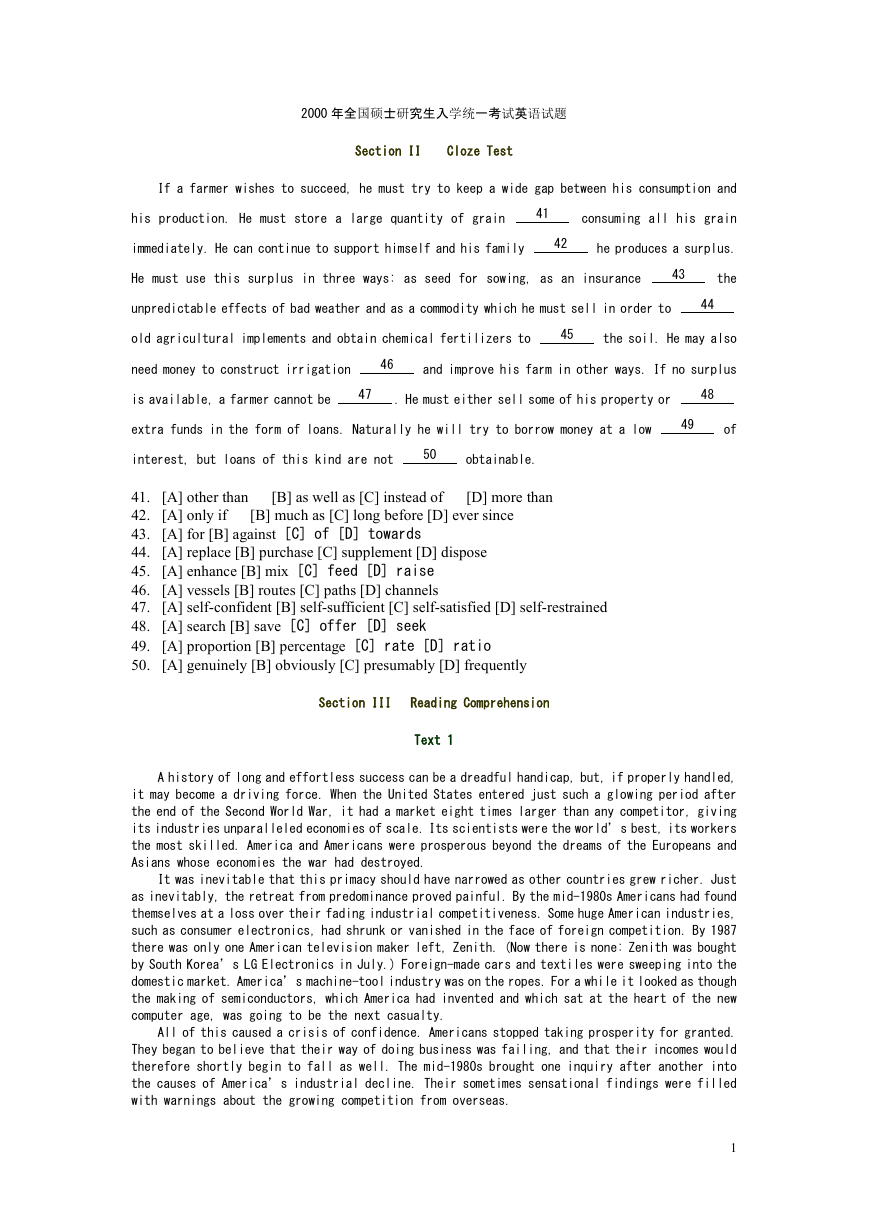
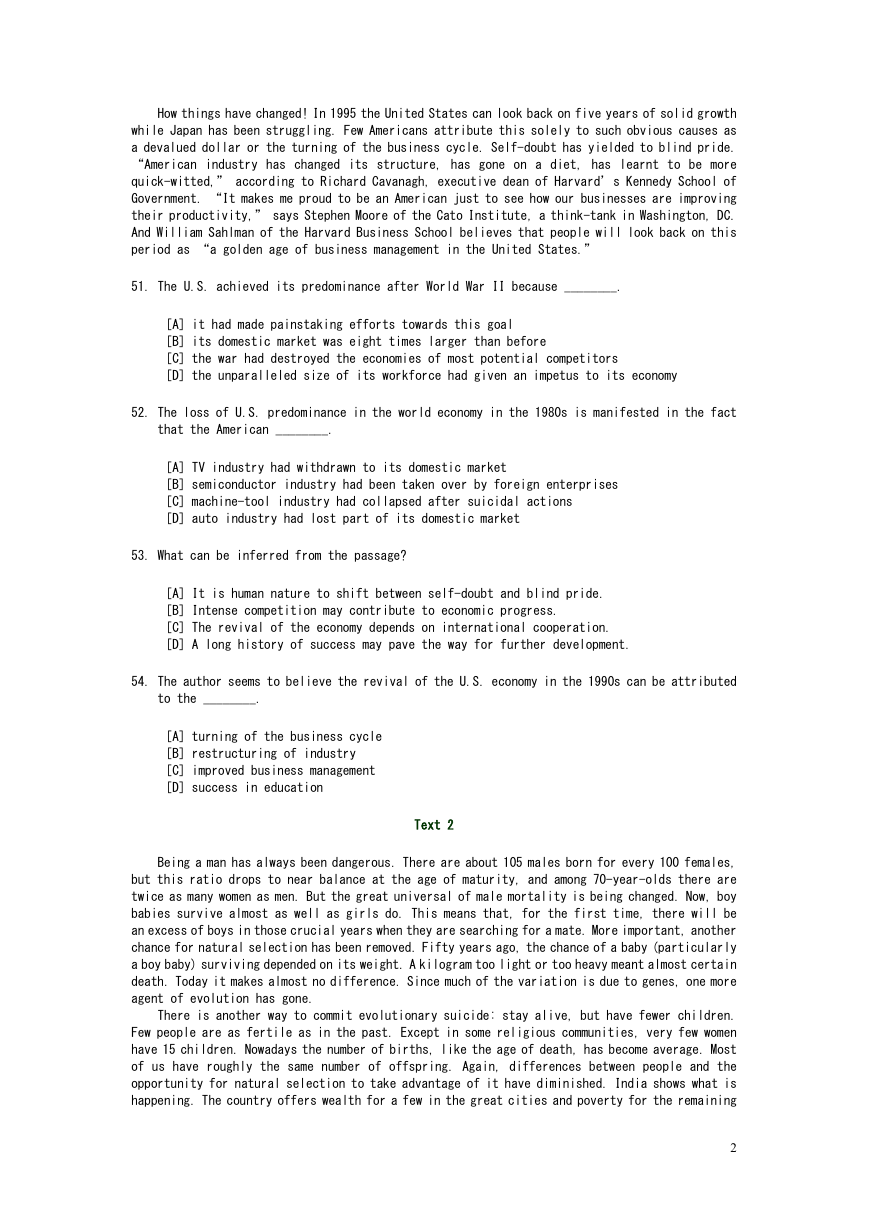
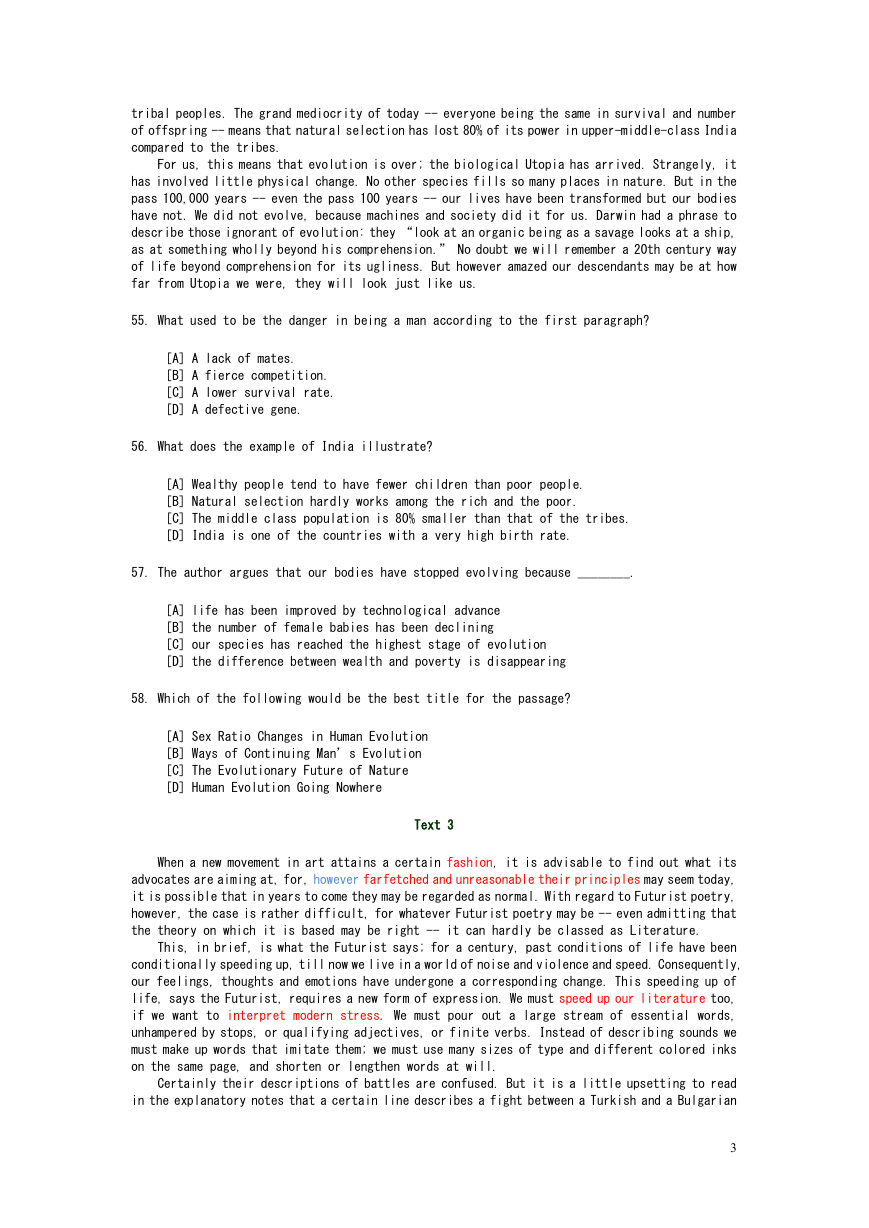
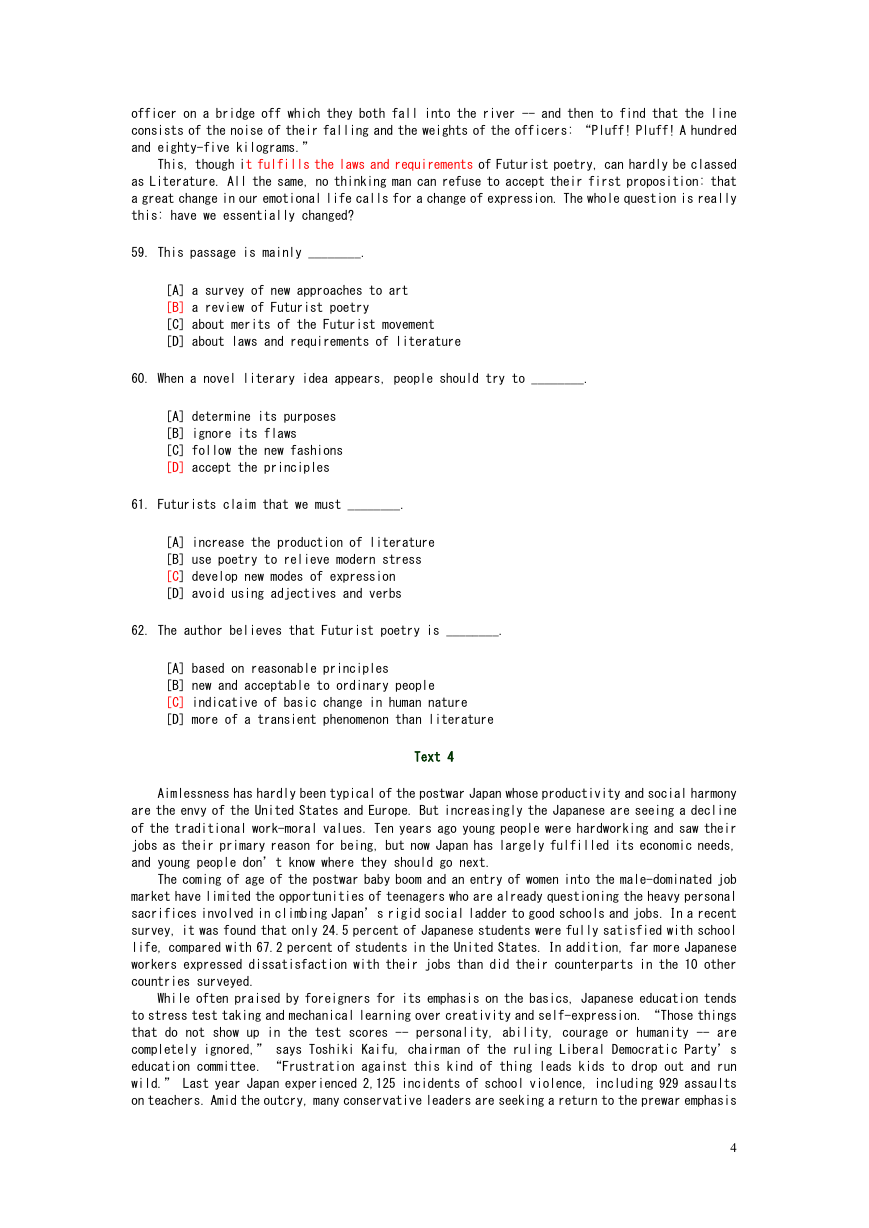
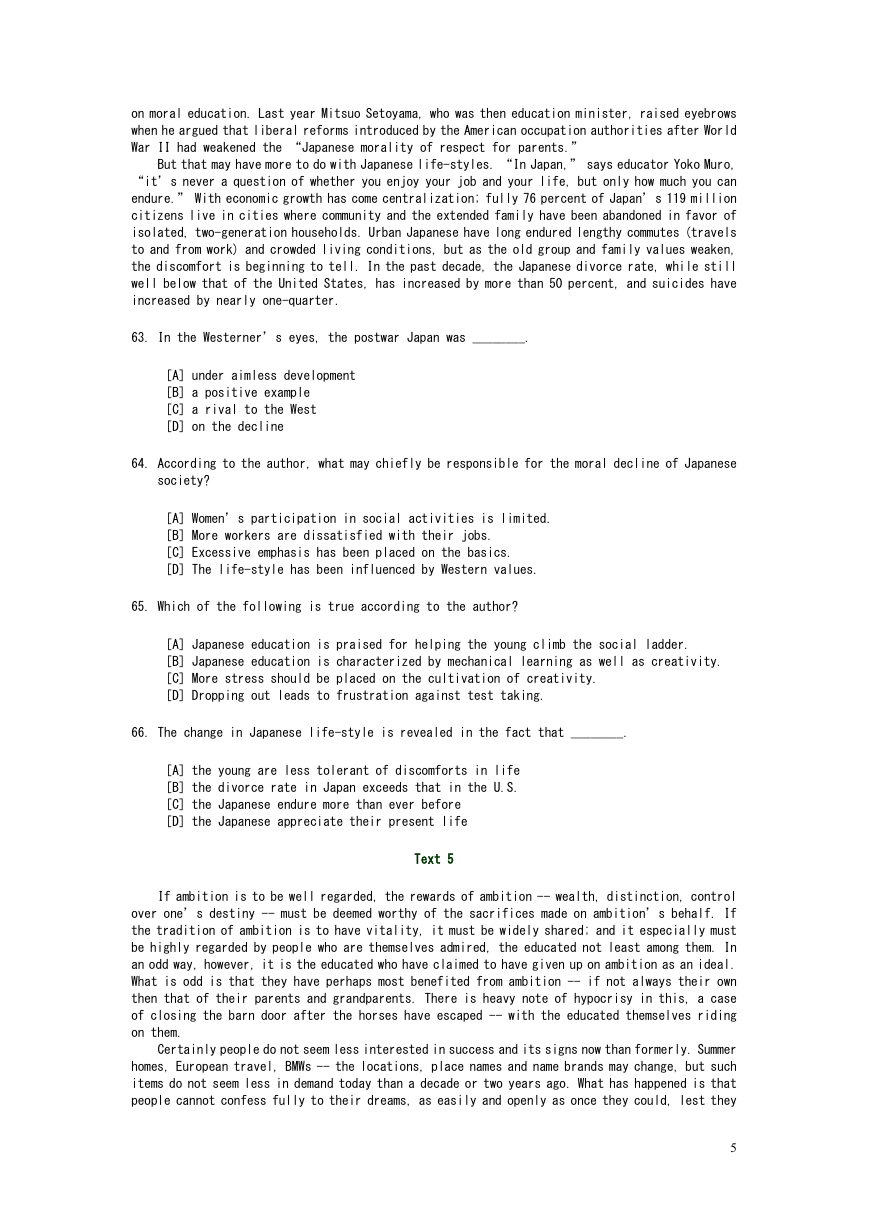
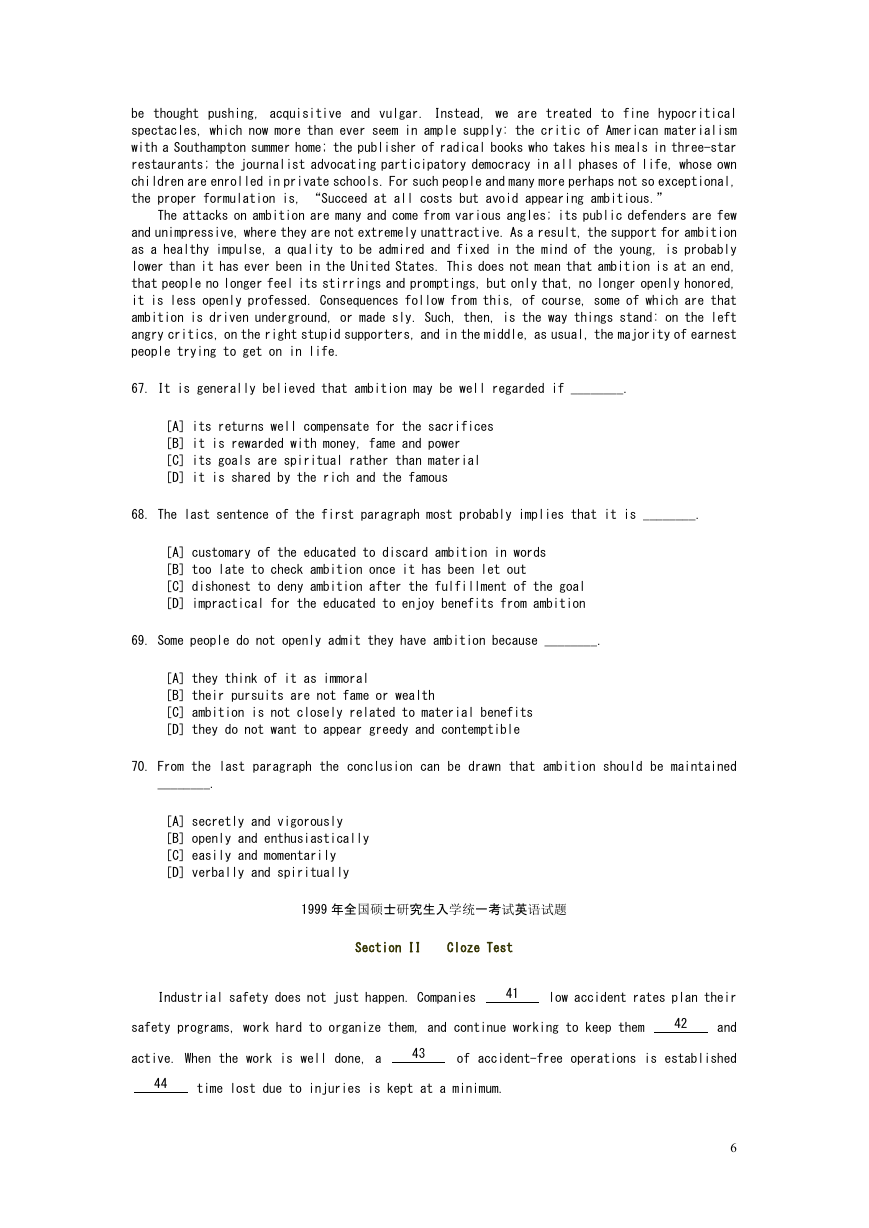

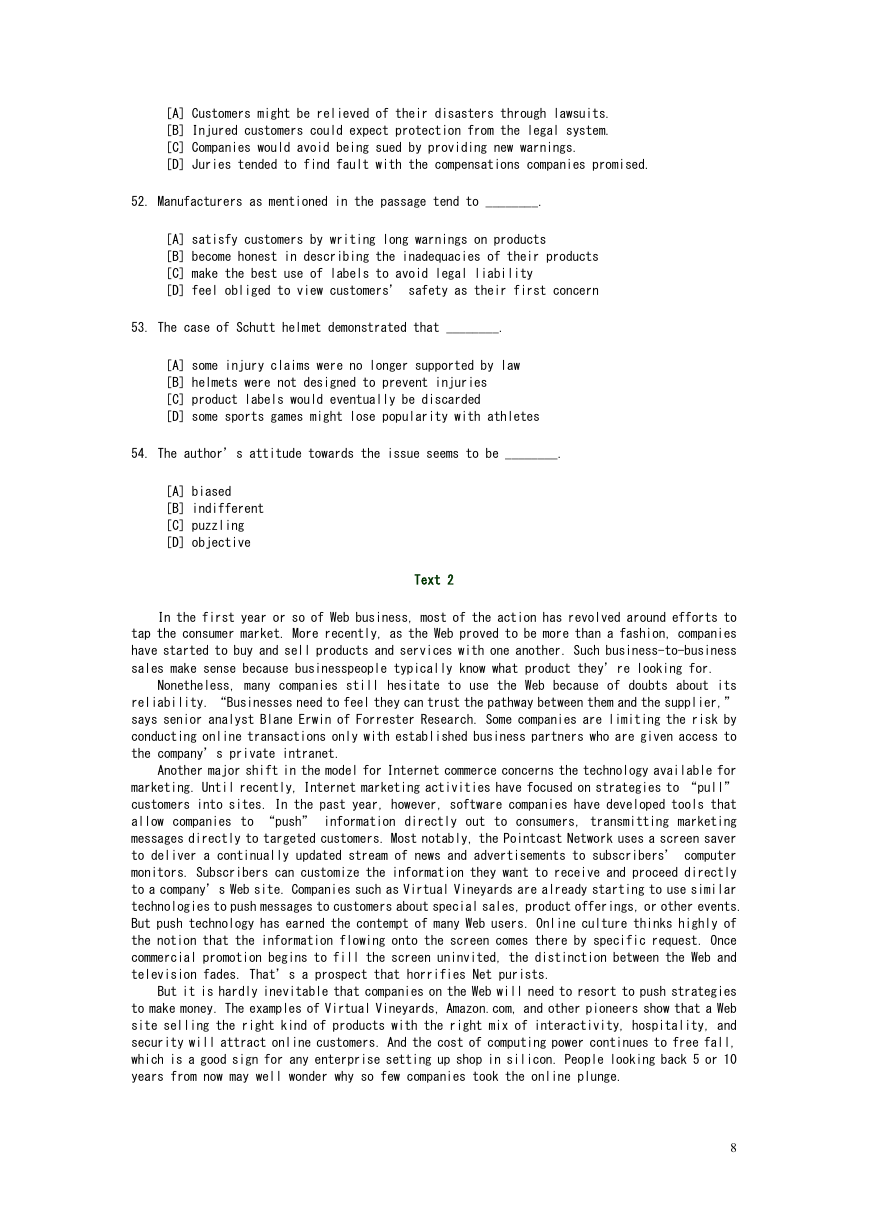








 2023年江西萍乡中考道德与法治真题及答案.doc
2023年江西萍乡中考道德与法治真题及答案.doc 2012年重庆南川中考生物真题及答案.doc
2012年重庆南川中考生物真题及答案.doc 2013年江西师范大学地理学综合及文艺理论基础考研真题.doc
2013年江西师范大学地理学综合及文艺理论基础考研真题.doc 2020年四川甘孜小升初语文真题及答案I卷.doc
2020年四川甘孜小升初语文真题及答案I卷.doc 2020年注册岩土工程师专业基础考试真题及答案.doc
2020年注册岩土工程师专业基础考试真题及答案.doc 2023-2024学年福建省厦门市九年级上学期数学月考试题及答案.doc
2023-2024学年福建省厦门市九年级上学期数学月考试题及答案.doc 2021-2022学年辽宁省沈阳市大东区九年级上学期语文期末试题及答案.doc
2021-2022学年辽宁省沈阳市大东区九年级上学期语文期末试题及答案.doc 2022-2023学年北京东城区初三第一学期物理期末试卷及答案.doc
2022-2023学年北京东城区初三第一学期物理期末试卷及答案.doc 2018上半年江西教师资格初中地理学科知识与教学能力真题及答案.doc
2018上半年江西教师资格初中地理学科知识与教学能力真题及答案.doc 2012年河北国家公务员申论考试真题及答案-省级.doc
2012年河北国家公务员申论考试真题及答案-省级.doc 2020-2021学年江苏省扬州市江都区邵樊片九年级上学期数学第一次质量检测试题及答案.doc
2020-2021学年江苏省扬州市江都区邵樊片九年级上学期数学第一次质量检测试题及答案.doc 2022下半年黑龙江教师资格证中学综合素质真题及答案.doc
2022下半年黑龙江教师资格证中学综合素质真题及答案.doc